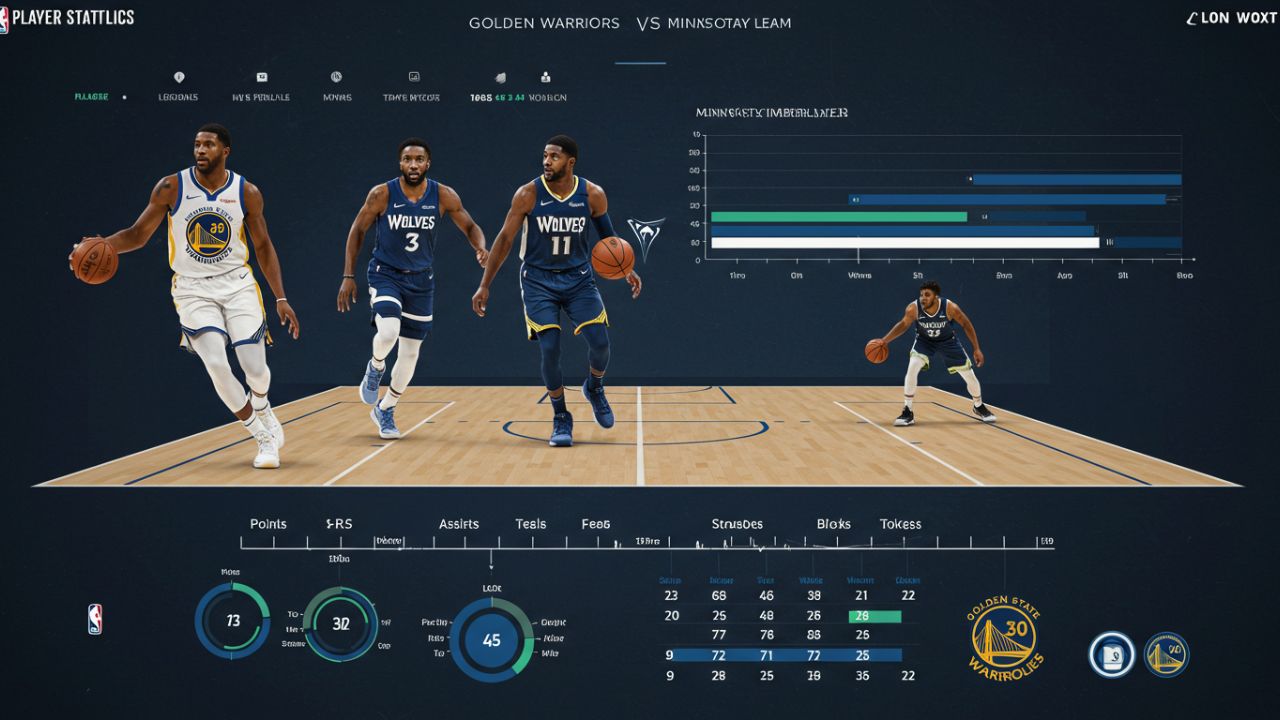The Golden State Warriors vs Timberwolves match player stats from the 2025 Western Conference Semifinals tell the story of two teams at very different points. The Timberwolves showed balance, energy, and confidence. The Warriors, meanwhile, fought hard but could not overcome injuries and aging veterans.
The series ended in five games, with the Timberwolves sealing the win and moving to the Western Conference Finals. Game 5 was the defining moment, and the numbers reveal exactly why Minnesota dominated. Let’s break down each game, spotlight the stars, and see how the series unfolded.
Game 5: Timberwolves Close Out in Style
The Timberwolves delivered a commanding performance in Game 5. Their offense was unstoppable, hitting 62.8% from the field and 41.9% from beyond the arc. Those shooting numbers alone explain why Golden State simply could not keep up.
-
Julius Randle was the star, scoring 29 points on 13-of-18 shooting, while also adding 8 rebounds and 5 assists. His efficient scoring and smart passing broke down the Warriors’ defense.
-
Anthony Edwards showed his all-around skills with 22 points, 12 assists, and 7 rebounds. His playmaking stood out as he created chances for teammates while still scoring efficiently.
-
Other role players added to the firepower, and Minnesota kept piling on the points.
On the Warriors’ side:
-
Brandin Podziemski stepped up with 28 points, showing why he is considered a rising star.
-
Jonathan Kuminga added 26 points off the bench, bringing energy and scoring when the starters struggled.
Yet without Stephen Curry, who missed the game due to a hamstring injury, Golden State lacked the firepower to keep pace.
Game 4: A Missed Opportunity for Warriors
Game 4 was close for much of the night, but Minnesota pulled away late to secure a 117–110 win. This put the Timberwolves in full control of the series with a 3–1 lead.
Anthony Edwards once again led the charge. His scoring ability and late-game shot-making silenced any hope of a Warriors comeback. Julius Randle also chipped in with steady scoring and rebounding.
Golden State tried to rally through Jimmy Butler and Jonathan Kuminga, but defensive lapses and turnovers proved costly.
Game 3: A Battle of Stars
Game 3 was the most competitive game of the series. Both teams traded baskets and played with intensity, but Minnesota managed to stay one step ahead.
-
Anthony Edwards exploded for 36 points, attacking the rim at will.
-
Julius Randle put up a triple-double with 24 points, 12 assists, and 10 rebounds, showing his versatility.
The Warriors had strong performances as well:
-
Jimmy Butler scored 33 points, reminding everyone of his big-game reputation.
-
Jonathan Kuminga added 30 points off the bench, making him one of the best performers of the night.
Still, Minnesota’s ability to balance scoring across multiple players proved decisive.
Game 2: Timberwolves Bounce Back
After dropping Game 1, the Timberwolves responded with force in Game 2. They dominated on both ends of the floor and secured a 24-point victory.
Julius Randle led the way with 24 points and 11 assists, while Anthony Edwards contributed 20 points. Their combined effort created a strong offensive rhythm, and the Warriors had no answer.
Without Curry, the Warriors looked lost offensively. Their reliance on perimeter shooting failed, and Minnesota tied the series.
Game 1: Warriors Steal the Opener
Despite missing their superstar guard Stephen Curry, the Warriors stunned Minnesota in Game 1. Their veterans and role players stepped up in his absence.
-
Buddy Hield hit five three-pointers and scored 24 points.
-
Jimmy Butler posted 20 points, 11 rebounds, and 8 assists, almost recording a triple-double.
-
Draymond Green contributed 18 points, showing leadership on both ends of the floor.
This victory gave the Warriors early hope, but it turned out to be their only win of the series.
Why the Timberwolves Won
The stats make it clear. The Timberwolves had balance, depth, and consistency. Randle and Edwards provided star power, but other players stepped in whenever needed. Their offense was efficient, and their defense forced the Warriors into tough shots.
On the other side, the Warriors relied too heavily on their veterans. With Curry out, the offense became predictable. Butler and Kuminga gave strong efforts, but it wasn’t enough to match Minnesota’s firepower.
Historical Context: Recent Matchups
Over their last 10 meetings, the Timberwolves have beaten the Warriors six times, averaging about 109 points per game compared to Golden State’s 107. This playoff series only reinforced the trend—Minnesota looks like the rising team, while Golden State faces big questions about the future.
What This Means for Both Teams
For Minnesota, the win marks back-to-back trips to the Western Conference Finals. Anthony Edwards is blossoming into a franchise superstar, while Julius Randle has become a reliable second option. The Timberwolves are no longer just a young team with potential—they are contenders.
For Golden State, the loss signals a turning point. Curry’s injury and the heavy reliance on aging stars like Draymond Green raise questions about the team’s direction. Younger players like Podziemski and Kuminga showed promise, but can they carry the torch?
Conclusion
The Golden State Warriors vs Timberwolves match player stats tell a simple story: one team was deep, efficient, and hungry, while the other was short-handed and struggling to keep pace.
The Timberwolves advanced with balance and teamwork. The Warriors showed flashes but ultimately could not survive without their best player.
This series might be remembered as the moment Minnesota fully arrived—and the moment Golden State finally faced the reality of change.

